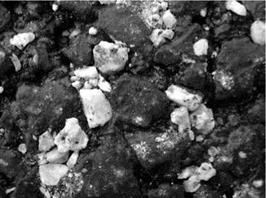Gritting Materials
Grits usually consist of different types of aggregates, such as the following:
• Aggregate 2/5 (or 2/4) mm, cleaned and hot, applied at a rate of 1.0-2.0 kg/ m2, for SMA with a gradation of at least 0/11 mm (Figure 10.14)
• Aggregate 1/3 mm, washed and hot, applied at a rate of 0.5-1.5 kg/m2, for SMA with any gradation
• Aggregate 0.25/2 mm, washed and hot, coated with about 1% binder (m/m), applied at a rate of 0.5-1.5 kg/m2, for SMA with any gradation but preferred for SMA 0/5 and 0/8
Generally, the use of finer grains for gritting means a lower quantity per square meter. Additionally the smaller the maximum aggregate size of the SMA, the smaller the grit grains that should be used.
|
FIGURE 10.14 Gritting particles among SMA coarse aggregates. (Photo courtesy of Krzysztof Blazejowski.) |
Gritting with aggregate 2/5 (2/4) mm is not recommended for SMA in Germany because it brings about an increase in noise generated by the contact between tires and the gritted pavement, (Druschner and Schafer, 2000). However, Dutch research has not proved an increase in noise caused by the use of grit (Jacobs and Fafie, 2004).
Gritting with an aggregate coated with binder provides a durable bond between the grit and the hot SMA layer. Attention should be paid to preventing an overdose of grit to avoid its sticking to the drums of a roller and destroying the hot layer surface. An overdosing of grit uncoated with binder can produce a similar effect (Jacobs and Fafie, 2004).
It is worth knowing that in British guidance (HAUC 2009), the aggregates for gritting should have a PSV not less than 55, which is more than the PSV of coarse aggregates used in an SMA skeleton in many countries (e. g., Germany, Poland, Hungary).







Leave a reply